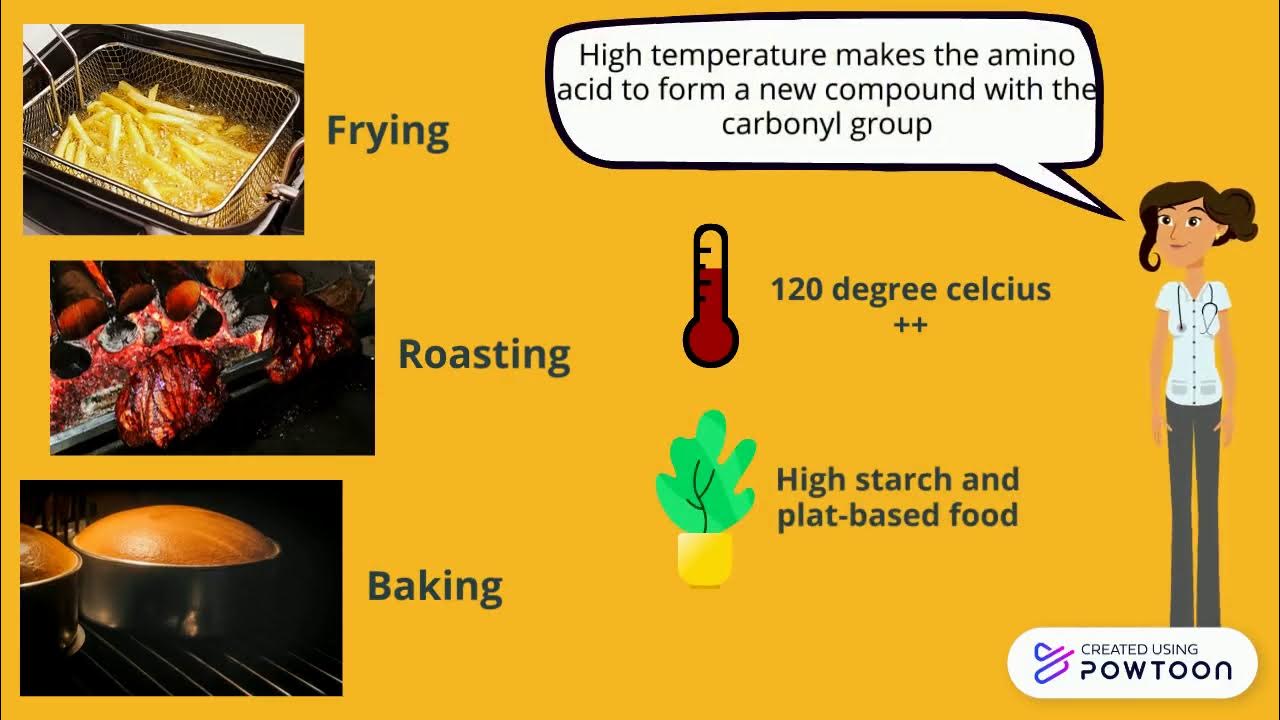Enzymatic Browning
Summary
TLDRThis video explains the concept of browning in food, focusing on enzymatic browning, a common color change seen in fruits and vegetables like apples, pears, and potatoes. It occurs when phenolic compounds react with oxygen in the presence of the enzyme polyphenol oxidase, resulting in the formation of brown pigments like melanin. The video also discusses methods to prevent browning, such as altering temperature, pH, or adding inhibitors like sugar, salt, or acids. Additionally, it highlights both the beneficial and detrimental effects of enzymatic browning in food products.
Takeaways
- 🍏 Browning in food is a common color change seen during pre-preparation, processing, or storage.
- 🥄 There are two types of browning: enzymatic browning and non-enzymatic browning.
- 🍎 Enzymatic browning occurs in foods like apples, pears, plantains, potatoes, and eggplants when they are exposed to air.
- 🔬 The three main components responsible for enzymatic browning are phenols or polyphenols, polyphenol oxidase (enzyme), and oxygen.
- 🧪 When phenolic compounds react with oxygen in the presence of the enzyme polyphenol oxidase, oxidation occurs, resulting in the formation of brown pigment called melanin.
- 🌡 Enzymatic browning can be prevented by altering temperature (blanching or freezing), pH levels (with acids), or by adding sugar or salt.
- ⛔ Methods to prevent enzymatic browning include using inhibitors like sulfur dioxide, sulfates, bisulfites, phosphates, or organic acids.
- 💧 Reducing oxygen exposure, such as immersing cut fruits in water or fruit juice, also helps prevent browning.
- 🍫 Enzymatic browning can have beneficial effects, such as producing desirable flavors and colors in products like black raisins, tea, coffee, and cocoa.
- 🚫 Detrimental effects of enzymatic browning include softening of the product, reduced shelf life, and unappealing visual changes such as black spots on seafood.
Q & A
What is enzymatic browning in food products?
-Enzymatic browning is a chemical reaction in fruits and vegetables that occurs when they are exposed to air. It is caused by the interaction of phenolic compounds with oxygen in the presence of the enzyme polyphenol oxidase, resulting in the formation of brown pigments.
What are the two main types of browning in food products?
-The two main types of browning in food products are enzymatic browning and non-enzymatic browning.
Which food products commonly exhibit enzymatic browning?
-Common food products that exhibit enzymatic browning include apples, pears, plantains, potatoes, and eggplants.
What are the key components involved in enzymatic browning?
-The key components involved in enzymatic browning are phenols or polyphenols, polyphenol oxidase (also known as phenolase), and oxygen.
What chemical reaction occurs during enzymatic browning?
-During enzymatic browning, phenolic compounds in fruits and vegetables react with oxygen in the presence of polyphenol oxidase, leading to the oxidation of phenols to orthoquinones, which then polymerize into melanin, causing the brown pigmentation.
How can enzymatic browning be prevented?
-Enzymatic browning can be prevented by methods such as altering temperature (blanching or refrigerating), reducing pH with acids like citric acid or ascorbic acid, adding inhibitors like sulfur dioxide or salts, and limiting oxygen exposure by immersing the product in water or juice.
What are the optimal pH levels for polyphenol oxidase activity, and how can it be reduced?
-The optimal pH level for polyphenol oxidase activity is between 6 and 7. It can be reduced to a pH of 4 by adding acids like citric acid or malic acid, which helps prevent enzymatic browning.
What are some beneficial effects of enzymatic browning?
-Beneficial effects of enzymatic browning include the production of desirable flavors and colors in products like black raisins, tea, coffee, and cocoa. The brown pigment melanin also has antimicrobial properties that help prevent infections in food products.
What are some detrimental effects of enzymatic browning?
-Detrimental effects of enzymatic browning include softening of the product, reduced shelf life, the formation of black spots on seafood like shrimps and lobsters, and overall unappealing appearance, which can affect the food's sensory properties.
How can simple solutions like adding sugar and salt help prevent enzymatic browning?
-Adding sugar or salt to cut fruits or vegetables can reduce enzymatic browning by creating a barrier that reduces the product’s exposure to oxygen, thus slowing the oxidation reaction.
Outlines

Cette section est réservée aux utilisateurs payants. Améliorez votre compte pour accéder à cette section.
Améliorer maintenantMindmap

Cette section est réservée aux utilisateurs payants. Améliorez votre compte pour accéder à cette section.
Améliorer maintenantKeywords

Cette section est réservée aux utilisateurs payants. Améliorez votre compte pour accéder à cette section.
Améliorer maintenantHighlights

Cette section est réservée aux utilisateurs payants. Améliorez votre compte pour accéder à cette section.
Améliorer maintenantTranscripts

Cette section est réservée aux utilisateurs payants. Améliorez votre compte pour accéder à cette section.
Améliorer maintenant5.0 / 5 (0 votes)






